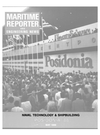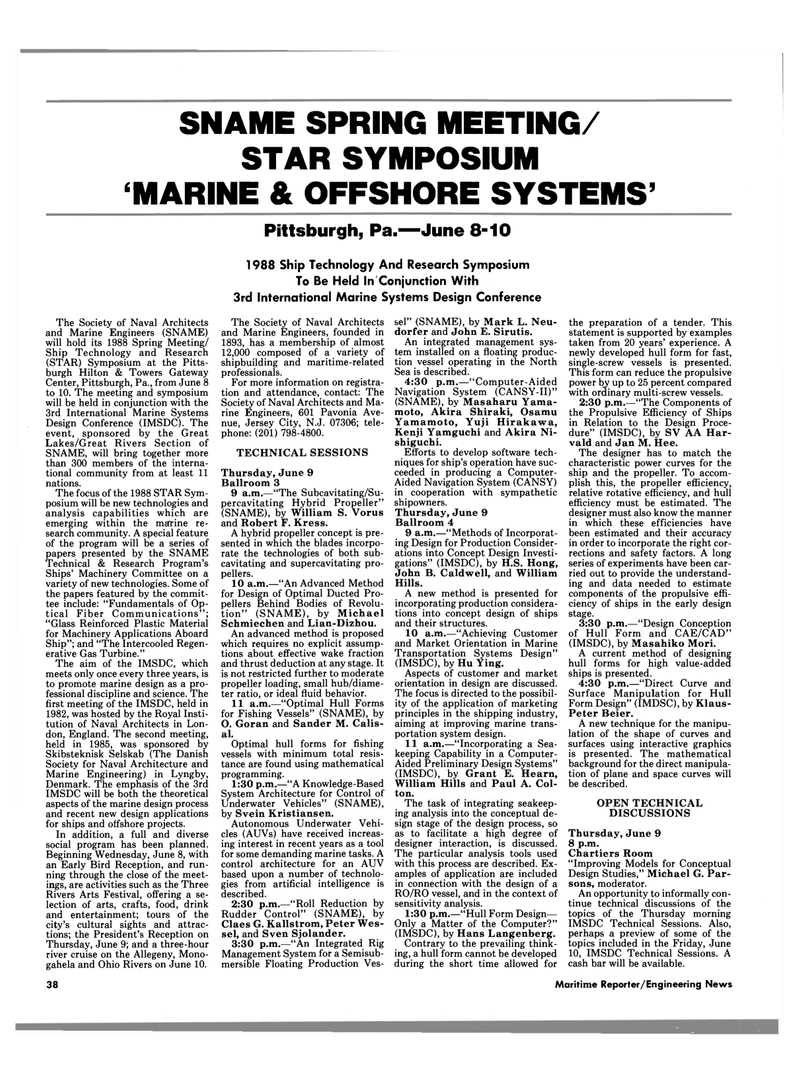
Page 36: of Maritime Reporter Magazine (May 1988)
Read this page in Pdf, Flash or Html5 edition of May 1988 Maritime Reporter Magazine
SNAME SPRING MEETING/
STAR SYMPOSIUM 'MARINE & OFFSHORE SYSTEMS'
Pittsburgh, Pa.—June 8-10 1988 Ship Technology And Research Symposium
To Be Held In Conjunction With 3rd International Marine Systems Design Conference
The Society of Naval Architects and Marine Engineers (SNAME) will hold its 1988 Spring Meeting/
Ship Technology and Research (STAR) Symposium at the Pitts- burgh Hilton & Towers Gateway
Center, Pittsburgh, Pa., from June 8 to 10. The meeting and symposium will be held in conjunction with the 3rd International Marine Systems
Design Conference (IMSDC). The event, sponsored by the Great
Lakes/Great Rivers Section of
SNAME, will bring together more than 300 members of the interna- tional community from at least 11 nations.
The focus of the 1988 STAR Sym- posium will be new technologies and analysis capabilities which are emerging within the mafrine re- search community. A special feature of the program will be a series of papers presented by the SNAME
Technical & Research Program's
Ships' Machinery Committee on a variety of new technologies. Some of the papers featured by the commit- tee include: "Fundamentals of Op- tical Fiber Communications"; "Glass Reinforced Plastic Material for Machinery Applications Aboard
Ship"; and "The Intercooled Regen- erative Gas Turbine."
The aim of the IMSDC, which meets only once every three years, is to promote marine design as a pro- fessional discipline and science. The first meeting of the IMSDC, held in 1982, was hosted by the Royal Insti- tution of Naval Architects in Lon- don, England. The second meeting, held in 1985, was sponsored by
Skibsteknisk Selskab (The Danish
Society for Naval Architecture and
Marine Engineering) in Lyngby,
Denmark. The emphasis of the 3rd
IMSDC will be both the theoretical aspects of the marine design process and recent new design applications for ships and offshore projects.
In addition, a full and diverse social program has been planned.
Beginning Wednesday, June 8, with an Early Bird Reception, and run- ning through the close of the meet- ings, are activities such as the Three
Rivers Arts Festival, offering a se- lection of arts, crafts, food, drink and entertainment; tours of the city's cultural sights and attrac- tions; the President's Reception on
Thursday, June 9; and a three-hour river cruise on the Allegeny, Mono- gahela and Ohio Rivers on June 10.
The Society of Naval Architects and Marine Engineers, founded in 1893, has a membership of almost 12,000 composed of a variety of shipbuilding and maritime-related professionals.
For more information on registra- tion and attendance, contact: The
Society of Naval Architects and Ma- rine Engineers, 601 Pavonia Ave- nue, Jersey City, N.J. 07306; tele- phone: (201) 798-4800.
TECHNICAL SESSIONS
Thursday, June 9
Ballroom 3 9 a.m.—"The Subcavitating/Su- percavitating Hybrid Propeller" (SNAME), by William S. Vorus and Robert F. Kress.
A hybrid propeller concept is pre- sented in which the blades incorpo- rate the technologies of both sub- cavitating and supercavitating pro- pellers. 10 a.m.—"An Advanced Method for Design of Optimal Ducted Pro- pellers Behind Bodies of Revolu- tion" (SNAME), by Michael
Schmiechen and Lian-Dizhou.
An advanced method is proposed which requires no explicit assump- tions about effective wake fraction and thrust deduction at any stage. It is not restricted further to moderate propeller loading, small hub/diame- ter ratio, or ideal fluid behavior. 11 a.m.—"Optimal Hull Forms for Fishing Vessels" (SNAME), by
O. Goran and Sander M. Calis- al.
Optimal hull forms for fishing vessels with minimum total resis- tance are found using mathematical programming. 1:30 p.m.—"A Knowledge-Based
System Architecture for Control of
Underwater Vehicles" (SNAME), by Svein Kristiansen.
Autonomous Underwater Vehi- cles (AUVs) have received increas- ing interest in recent years as a tool for some demanding marine tasks. A control architecture for an AUV based upon a number of technolo- gies from artificial intelligence is described. 2:30 p.m.—"Roll Reduction by
Rudder Control" (SNAME), by
Claes G. Kallstrom, Peter Wes- sel, and Sven Sjolander. 3:30 p.m.—"An Integrated Rig
Management System for a Semisub- mersible Floating Production Ves- sel" (SNAME), by Mark L. Neu- dorfer and John E. Sirutis.
An integrated management sys- tem installed on a floating produc- tion vessel operating in the North
Sea is described. 4:30 p.m.—"Computer-Aided
Navigation System (CANSY-II)" (SNAME), by Masaharu Yama- moto, Akira Shiraki, Osamu
Yamamoto, Yuji Hirakawa,
Kenji Yamguchi and Akira Ni- shiguchi.
Efforts to develop software tech- niques for ship's operation have suc- ceeded in producing a Computer-
Aided Navigation System (CANSY) in cooperation with sympathetic shipowners.
Thursday, June 9
Ballroom 4 9 a.m.—"Methods of Incorporat- ing Design for Production Consider- ations into Concept Design Investi- gations" (IMSDC), by H.S. Hong,
John B. Caldwell, and William
Hills.
A new method is presented for incorporating production considera- tions into concept design of ships and their structures. 10 a.m.—"Achieving Customer and Market Orientation in Marine
Transportation Systems Design" (IMSDC), by Hu Ying.
Aspects of customer and market orientation in design are discussed.
The focus is directed to the possibil- ity of the application of marketing principles in the shipping industry, aiming at improving marine trans- portation system design. 11 a.m.—"Incorporating a Sea- keeping Capability in a Computer-
Aided Preliminary Design Systems" (IMSDC), by Grant E. Hearn,
William Hills and Paul A. Col- ton.
The task of integrating seakeep- ing analysis into the conceptual de- sign stage of the design process, so as to facilitate a high degree of designer interaction, is discussed.
The particular analysis tools used with this process are described. Ex- amples of application are included in connection with the design of a
RO/RO vessel, and in the context of sensitivity analysis. 1:30 p.m.—"Hull Form Design-
Only a Matter of the Computer?" (IMSDC), by Hans Langenberg.
Contrary to the prevailing think- ing, a hull form cannot be developed during the short time allowed for the preparation of a tender. This statement is supported by examples taken from 20 years' experience. A newly developed hull form for fast, single-screw vessels is presented.
This form can reduce the propulsive power by up to 25 percent compared with ordinary multi-screw vessels. 2:30 p.m.—"The Components of the Propulsive Efficiency of Ships in Relation to the Design Proce- dure" (IMSDC), by SV AA Har- vald and Jan M. Hee.
The designer has to match the characteristic power curves for the ship and the propeller. To accom- plish this, the propeller efficiency, relative rotative efficiency, and hull efficiency must be estimated. The designer must also know the manner in which these efficiencies have been estimated and their accuracy in order to incorporate the right cor- rections and safety factors. A long series of experiments have been car- ried out to provide the understand- ing and data needed to estimate components of the propulsive effi- ciency of ships in the early design stage. 3:30 p.m.—"Design Conception of Hull Form and CAE/CAD" (IMSDC), by Masahiko Mori.
A current method of designing hull forms for high value-added ships is presented. 4:30 p.m.—"Direct Curve and
Surface Manipulation for Hull
Form Design" (IMDSC), by Klaus-
Peter Beier.
A new technique for the manipu- lation of the shape of curves and surfaces using interactive graphics is presented. The mathematical background for the direct manipula- tion of plane and space curves will be described.
OPEN TECHNICAL
DISCUSSIONS
Thursday, June 9 8 p.m.
Chartiers Room "Improving Models for Conceptual
Design Studies," Michael G. Par- sons, moderator.
An opportunity to informally con- tinue technical discussions of the topics of the Thursday morning
IMSDC Technical Sessions. Also, perhaps a preview of some of the topics included in the Friday, June 10, IMSDC Technical Sessions. A cash bar will be available. 38 Maritime Reporter/Engineering News

 35
35

 37
37
